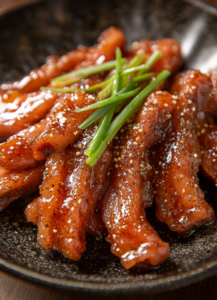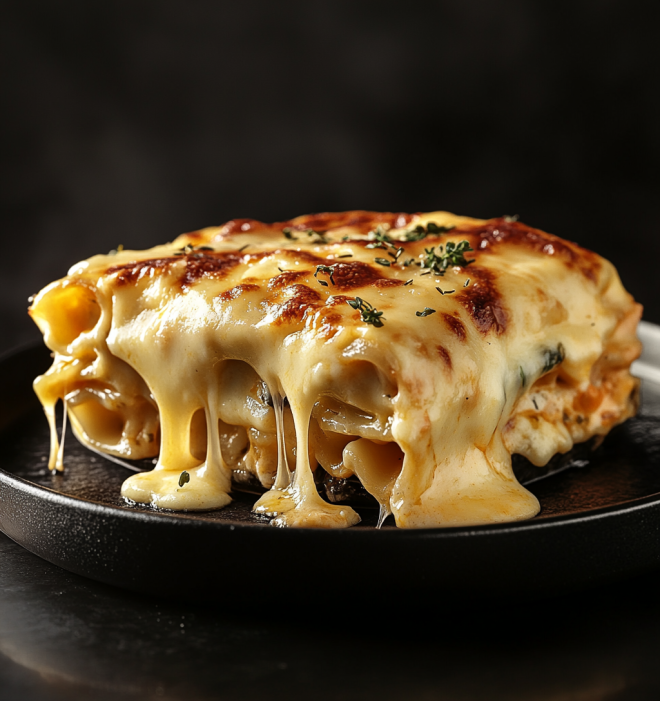Sweet and Sour Pork
Jump to Recipe
Get ready to dive into the vibrant and delicious world of Sweet and Sour Pork, a classic Chinese dish that perfectly balances sweet and tangy flavors. Originating from Quanzhou, this recipe showcases the rich culinary traditions of the region and is sure to become a favorite in your home!
Ingredients
For the Marinade:
- 2 tablespoons Chinese dark vinegar (Zhenjiang vinegar recommended)
- 1 tablespoon soy sauce
- 1 tablespoon sugar
- 1 tablespoon rice wine
- ½ teaspoon five-spice powder
For the Pork:
- 500 grams pork scotch fillet or pork tenderloin, cut into bite-sized pieces
For the Batter:
- ½ cup cornstarch
- ¼ cup all-purpose flour
For Frying:
- Vegetable oil, for deep frying
Directions
Step 1: Marinate the Pork
In a bowl, whisk together the Chinese dark vinegar, soy sauce, sugar, rice wine, and five-spice powder. Add the pork pieces, ensuring they’re evenly coated. Let them marinate for at least 30 minutes to soak up all those amazing flavors.
Step 2: Prepare the Batter
After marinating, drain any excess marinade from the pork. In a separate bowl, combine the cornstarch and all-purpose flour. Coat each piece of pork thoroughly with this dry mixture, ensuring they’re well covered.
Step 3: Heat the Oil
In a deep frying pan or wok, pour in enough vegetable oil to fill it about 2 inches deep. Heat the oil over medium-high heat until it reaches approximately 350°F (175°C).
Step 4: Deep-Fry the Pork
Carefully place the coated pork pieces into the hot oil, frying them in batches to avoid overcrowding. Fry until golden brown and crispy, about 3-4 minutes per batch. Once cooked, remove them and drain on paper towels.
Step 5: Optional Stir-Fry
For an extra layer of flavor and texture, stir-fry the fried pork with vegetables like tomatoes and baby leeks. Heat a tablespoon of oil in a wok, add the veggies, and cook until tender. Toss in the fried pork to combine everything beautifully.
Step 6: Serve
Arrange your sweet and sour pork on a serving platter and enjoy it immediately while it’s still crispy and delicious!
Nutrition Facts (Per 100 grams)
- Calories: Approximately 250 kcal
- Protein: 15 grams
- Carbohydrates: 20 grams
- Sugars: 5 grams
- Fat: 12 grams
- Saturated Fat: 3 grams
- Cholesterol: 45 mg
- Sodium: 400 mg
- Fiber: 1 gram
The History and Significance of Sweet and Sour Pork
Sweet and sour pork is one of the most iconic dishes in Chinese cuisine, particularly in Cantonese cooking. Its roots trace back to ancient China, where vinegar and honey were used to preserve and enhance flavors. Over the centuries, this dish has evolved into the delightful sweet and tangy masterpiece we know today. Gaining popularity during the late Qing Dynasty, it transformed from a humble peasant dish to a beloved staple in Chinese restaurants worldwide, embraced by food lovers across cultures.
Why Sweet and Sour Pork is So Popular
The universal appeal of sweet and sour pork lies in its perfect combination of textures and flavors. The crispy, deep-fried pork pairs beautifully with a sticky, flavorful sauce, creating a satisfying contrast. The sweetness from sugar, tang from vinegar, and umami from soy sauce come together to create a dish that pleases the palate and leaves you wanting more.
Variations of Sweet and Sour Pork
While the traditional Cantonese-style sweet and sour pork is a classic, you’ll find many delightful variations around the globe:
- Chinese-American Style: Often includes bell peppers, pineapple, and onions in a thick, glossy sauce made with ketchup and cornstarch, offering a sweeter taste and vibrant color.
- Hong Kong Style: Utilizes fresh tomatoes for a lighter, slightly tart flavor, resulting in a refreshing dish.
- Chinese-British Style: Found in takeaways, featuring large chunks of battered pork served with a separate sweet and sour dipping sauce.
- Thai Sweet and Sour Pork: Incorporates fish sauce and a hint of spice, balancing sweet, sour, salty, and spicy flavors.
- Filipino Style (Pork Asado): This version uses a tomato-based sauce and is sometimes cooked with pineapple juice for a tropical twist.
Tips for the Best Sweet and Sour Pork
- Use the Right Cut of Pork: Opt for cuts with some fat, like pork shoulder or scotch fillet, to keep the meat tender and juicy after frying.
- Marinate for Maximum Flavor: Allow the pork to marinate for at least 30 minutes to enhance taste and tenderness.
- Double-Fry for Extra Crispiness: For the crispiest pork, fry it twice—first at a lower temperature to cook through, then again at a higher temperature for that golden crunch.
- Balance the Sauce: The secret to a perfect sweet and sour sauce is balancing sugar, vinegar, and soy sauce. Adjust the proportions to suit your taste.
- Avoid Overcrowding the Pan: Fry the pork in small batches to ensure each piece gets crispy without becoming soggy.
- Add Vegetables for Texture and Color: Bell peppers, onions, and pineapples not only enhance flavor but also add freshness to the dish.
Health Considerations and Modifications
While sweet and sour pork is undeniably delicious, it can be high in calories and fat. Here are some ways to create a healthier version:
- Use Leaner Cuts of Meat: Choose pork tenderloin or loin for a leaner option.
- Bake Instead of Frying: Baking or air frying the pork can significantly reduce oil consumption.
- Reduce Sugar: Swap refined sugar for honey or a natural sweetener for a healthier sauce.
- Add More Vegetables: Boost the nutritional value by increasing the amount of bell peppers, carrots, and onions.
Pairing Suggestions
To create a well-rounded meal, serve sweet and sour pork with complementary side dishes:
- Steamed Jasmine Rice: The neutral flavor of rice balances the tangy sauce perfectly.
- Fried Rice: A classic combination that enhances the dish’s flavors.
- Stir-Fried Vegetables: Fresh veggies like bok choy, Chinese broccoli, or snow peas add a delightful crunch.
- Hot and Sour Soup: A perfect appetizer to start your meal.
Conclusion
Sweet and sour pork is a timeless dish that has captured the hearts of food lovers around the globe. Its perfect balance of flavors, crispy texture, and vibrant appearance make it a favorite for home cooks and restaurant chefs alike. Whether you stick to the traditional Cantonese version or explore different variations, this dish is guaranteed to be a crowd-pleaser that will have everyone coming back for seconds! 🍽️🥢✨








